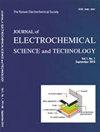铜绿假单胞菌ZK生物膜对316L不锈钢和α-黄铜力学和腐蚀行为的影响
IF 3
4区 工程技术
Q3 ELECTROCHEMISTRY
Journal of electrochemical science and technology
Pub Date : 2021-06-09
DOI:10.33961/JECST.2020.01718
引用次数: 1
摘要
本研究旨在研究好氧细菌铜绿假单胞菌对316L不锈钢和α-黄铜力学和电化学性能的影响。这两种合金的这些性能是在37℃暴露于受控和接种的培养基7天后测定的。微观结构和电化学测试结果揭示了铜绿假单胞菌的有害影响。在暴露于接种介质后,扫描电子显微镜(SEM)结果显示,与316L不锈钢相比,α-黄铜上有更大的点蚀和相对致密的生物膜形成。316L不锈钢的拉伸强度和硬度在暴露于受控和接种介质后略有影响。在暴露于受控培养基和接种培养基后,α-黄铜的拉伸强度受到的影响最小,但由于铜绿假单胞菌引起的严重攻击,观察到硬度显著降低(从165 HV降至124 HV)。类似地,316L不锈钢在接种介质中的开路电位被测得比α-黄铜(-550 mV vs Ag/AgCl)活性更低(-410 mV vs Ag/AgCl。在接种的介质中,动电位极化曲线证实了铜绿假单胞菌对α-黄铜的严重侵蚀(7.15×10 mm/年),而316L不锈钢的腐蚀速率为5.14×10 mm/年。本文章由计算机程序翻译,如有差异,请以英文原文为准。
Effect of Pseudomonas aeruginosa Strain ZK Biofilm on the Mechanical and Corrosion Behavior of 316L Stainless Steel and α-brass
This research work aims to investigate the effect of the aerobic bacterium, Pseudomonas aeruginosa on the mechanical and electrochemical properties of the 316L stainless steel and α-brass. These properties of both the alloys were determined after 7 days of exposure to the controlled and inoculated media at 37C. The microstructural and electrochemical test results revealed the deleterious effects of Pseudomonas aeruginosa. After exposure to the inoculated medium, the scanning electron microscopy (SEM) results showed the larger pitting and formation of relatively dense biofilm on α-brass compared to 316L stainless steel. The tensile strength and hardness of 316L stainless steel were slightly affected after exposure to the controlled and inoculated media. After exposure to the controlled medium and inoculated media, the tensile strength of the α-brass was least affected but a significant decrease in the hardness (from 165 HV to 124 HV) was observed due to the severe attack induced by the Pseudomonas aeruginosa. Similarly, the open-circuit potential of the 316L stainless steel in the inoculated medium was measured to be less active (-410 mV vs Ag/AgCl) than α-brass (-550 mV vs Ag/AgCl). In the inoculated medium, potentiodynamic polarization curves confirmed the severe attack of Pseudomonas aeruginosa on α-brass (7.15 × 10 mm/year) compared to 316L stainless steel which registered a corrosion rate of 5.14 × 10 mm/year.
求助全文
通过发布文献求助,成功后即可免费获取论文全文。
去求助
来源期刊

Journal of electrochemical science and technology
ELECTROCHEMISTRY-
CiteScore
6.30
自引率
8.10%
发文量
44
期刊介绍:
Covering fields:
- Batteries and Energy Storage
- Biological Electrochemistry
- Corrosion Science and Technology
- Electroanalytical Chemistry and Sensor Technology
- Electrocatalysis
- Electrochemical Capacitors & Supercapcitors
- Electrochemical Engineering
- Electrodeposition and Surface Treatment
- Environmental Science and Technology
- Fuel Cells
- Material Electrochemistry
- Molecular Electrochemistry and Organic Electrochemistry
- Physical Electrochemistry
- Solar Energy Conversion and Photoelectrochemistry
 求助内容:
求助内容: 应助结果提醒方式:
应助结果提醒方式:


